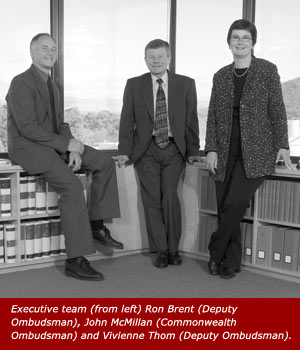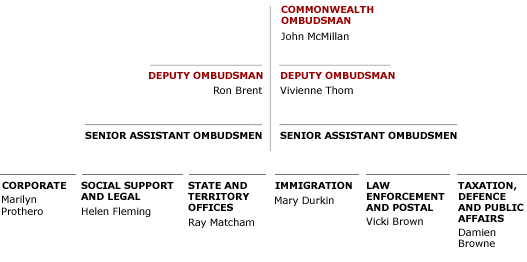Commonwealth Ombudsman Annual Report 2005-06 | Chapter 2 | The organisation


CHAPTER 2 | The organisation
History and establishment
The office of the Commonwealth Ombudsman was established by the Ombudsman Act 1976, and is administered by the Prime Minister. In 1971, the Commonwealth Administrative Review Committee issued a report recommending the establishment of a Commonwealth Ombudsman. The committee proposed a new and distinctive system of administrative law in Australia. It envisaged that the Ombudsman would play a part, along with courts and administrative tribunals, in examining government administrative action.
The office commenced operation on 1 July 1977. Since then, seven Commonwealth Ombudsmen have been in office. Over time the responsibilities of the Ombudsman have expanded to cover:
- complaints about the Australian Federal Police—1981
- complaints about freedom of information—1982
- Defence Force Ombudsman role—1983
- compliance auditing of AFP and National Crime Authority (now Australian Crime Commission) telecommunications intercept records—1988, with added responsibilities of monitoring controlled operations in 2001 and auditing surveillance device records in 2004
- Australian Capital Territory Ombudsman—1989
- Special Tax Adviser function—1995
- assessing and reporting on the detention of long-term (two years or more) immigration detainees—2005
- Immigration Ombudsman role—2005
- Commonwealth service providers—2005
- Postal Industry Ombudsman role—2006
- Law Enforcement Ombudsman role—2006.
Role and functions
The office of Commonwealth Ombudsman exists to safeguard the community in its dealings with government agencies, and to ensure that administrative action by Australian Government agencies is fair and accountable. The Ombudsman has three major statutory roles:
- Complaint investigation: the investigation and review of the administrative actions of Australian Government officials and agencies, upon receipt of complaints from members of the public, groups and organisations
- Own motion investigation: the investigation, on the initiative or 'own motion' of the Ombudsman, of the administrative actions of Australian Government agencies—often arising from insights gained from handling individual complaints
- Compliance auditing: inspection of the records of agencies such as the Australian Federal Police (AFP) and Australian Crime Commission, to ensure compliance with legislative requirements applying to selected law enforcement and regulatory activities.
'The Commonwealth Ombudsman exists to ... ensure that administrative action by Australian Government agencies is fair and accountable.'
The complaint and own motion investigation roles of the Ombudsman are the more traditional ombudsman roles that constitute the bulk of the work of the office. The guiding principle in an ombudsman investigation is whether the administrative action under investigation is unlawful, unreasonable, unjust, oppressive, improperly discriminatory, factually deficient, or otherwise wrong. At the conclusion of the investigation, the Ombudsman can recommend that an agency take corrective action. This occurs either specifically in an individual case or generally by a change to relevant legislation, administrative policies or procedures.
A key objective of the Ombudsman is to foster good public administration within Australian Government agencies, ensuring that the principles and practices of public administration are responsive to the interests of members of the public.
The role of the Commonwealth Ombudsman is principally performed under the Ombudsman Act 1976 (Cth) (Ombudsman Act), the Complaints (Australian Federal Police) Act 1981 (Cth) (Complaints Act) and the Ombudsman Act 1989 (ACT).
The Commonwealth Ombudsman can consider complaints about almost all Australian Government departments and agencies and most contractors delivering government services to the community.
The Ombudsman Act also confers four specialist roles on the Ombudsman:
- Defence Force Ombudsman—handling grievances lodged by serving and former members of the Australian Defence Force
- Immigration Ombudsman—handling complaints about the Department of Immigration and Multicultural Affairs
- Postal Industry Ombudsman—handling complaints about Australia Post and private postal operators registered with the Postal Industry Ombudsman scheme
- Taxation Ombudsman—handling complaints about the Australian Taxation Office.
Other specialist roles relate to:
- Australian Federal Police—under the Complaints Act, the Commonwealth Ombudsman and the AFP are jointly responsible for managing complaints about AFP members. These members may be employed in international, national and ACT community policing duties.
Reforms to the AFP complaint-handling system, which change the Ombudsman's current role, are contained in the Law Enforcement (AFP Professional Standards and Related Measures) Act 2006, which is awaiting proclamation. The Act designates the Commonwealth Ombudsman as the Law Enforcement Ombudsman. - ACT Ombudsman—the Commonwealth Ombudsman is also the ACT Ombudsman in accordance with s 28 of the ACT Self-Government (Consequential Provisions) Act 1988 (Cth). The role of ACT Ombudsman is performed under the Ombudsman Act 1989 (ACT), and is funded in accordance with a memorandum of understanding between the Commonwealth Ombudsman and the ACT Government. The ACT Ombudsman submits an annual report to the ACT Legislative Assembly on the performance of the ACT Ombudsman function.
Organisation and structure
 The national office of the Commonwealth Ombudsman and the office
of the ACT Ombudsman are co-located in Canberra. The Commonwealth Ombudsman also has offices in Adelaide, Brisbane, Darwin, Hobart, Melbourne, Perth and Sydney.
The national office of the Commonwealth Ombudsman and the office
of the ACT Ombudsman are co-located in Canberra. The Commonwealth Ombudsman also has offices in Adelaide, Brisbane, Darwin, Hobart, Melbourne, Perth and Sydney.
The Ombudsman and the two Deputy Ombudsmen are statutory officers appointed under the Ombudsman Act (Cth). Staff are employed under the Public Service Act 1999.
The office comprises a range of functional elements:
- central office functions and responsibilities (including human resources, information technology, financial services, records management and public affairs) and the principal specialist teams are based in the national office in Canberra
- offices throughout Australia handle complaints and undertake some specialist work. A Senior Assistant Ombudsman supervises the state and territory offices, and complaint handling relating to the ACT Ombudsman function.
Details on the office's senior executive and their responsibilities are set out in Chapter 4—Management and accountability.
Figure 2.1 illustrates the organisational structure of the Ombudsman's office.
FIGURE 2.1 Commonwealth Ombudsman organisational structure at 30 June 2006

Outcome and output structure
Our strategic plan provides broad direction for our work and the Portfolio Budget Statements define one central outcome for the office, supported by two outputs.
The central outcome is administrative action by Australian Government agencies that is fair and accountable. The supporting outputs are the:
- review of administrative action
- review of statutory compliance in specified areas.
Details of the Commonwealth Ombudsman's achievement of the outcome and outputs are in Chapter 3—Performance Report.
